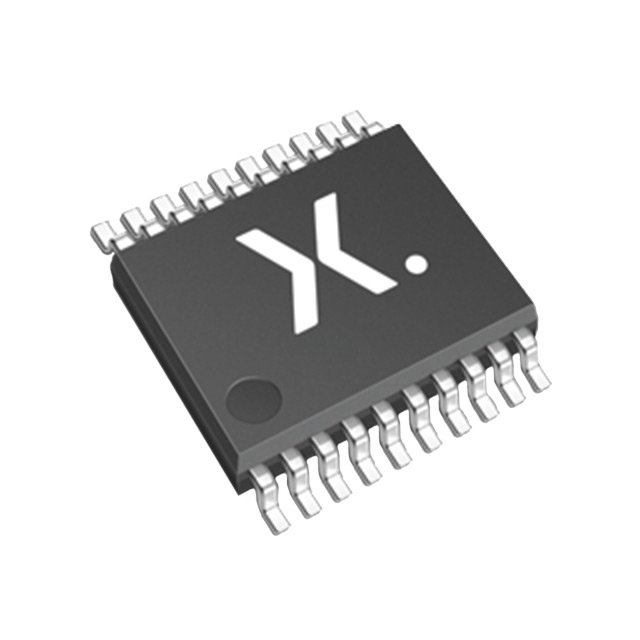74LV245PW,112
Basic Information Overview
- Category: Integrated Circuit (IC)
- Use: Level Shifter/Transceiver
- Characteristics: Bidirectional voltage level translation, 3-state outputs, wide operating voltage range
- Package: TSSOP (Thin Shrink Small Outline Package)
- Essence: Translates signals between different voltage levels in electronic circuits
- Packaging/Quantity: Tape and Reel, 2500 pieces per reel
Specifications
- Supply Voltage Range: 1.65V to 5.5V
- Input Voltage Range: -0.5V to VCC + 0.5V
- Output Voltage Range: 0V to VCC
- Maximum Operating Frequency: 30MHz
- Number of Channels: 8
- Logic Family: LV (Low Voltage)
Detailed Pin Configuration
The 74LV245PW,112 has a total of 20 pins. The pin configuration is as follows:
__ __
A1 |1 \__/ 20| VCC
B1 |2 19| OE#
A2 |3 18| I/O1B
B2 |4 17| I/O2B
A3 |5 16| I/O3B
B3 |6 15| I/O4B
A4 |7 14| I/O5B
B4 |8 13| I/O6B
GND |9 12| I/O7B
OE |10 11| I/O8B
----------
Functional Features
- Bidirectional voltage level translation: Allows for seamless communication between devices operating at different voltage levels.
- 3-state outputs: Provides the ability to disconnect the output from the bus, allowing multiple devices to share the same bus without interference.
- Wide operating voltage range: Supports a wide range of input and output voltage levels, making it versatile for various applications.
Advantages and Disadvantages
Advantages: - Efficient voltage level translation between different logic families. - 3-state outputs enable bus sharing and reduce power consumption. - Wide operating voltage range allows compatibility with various systems.
Disadvantages: - Limited maximum operating frequency compared to some other level shifters. - TSSOP package may require careful handling during assembly.
Working Principles
The 74LV245PW,112 is a bidirectional level shifter/transceiver. It uses a combination of MOSFETs and control logic to translate signals between different voltage levels. The direction of signal flow is controlled by the OE (Output Enable) pin. When OE is low, the device is in the active state, allowing bidirectional communication. When OE is high, the outputs are in a high-impedance state, effectively disconnecting them from the bus.
Detailed Application Field Plans
The 74LV245PW,112 is commonly used in various electronic systems where voltage level translation is required. Some typical application fields include: - Communication interfaces between microcontrollers and peripheral devices operating at different voltage levels. - Interfacing between different logic families, such as TTL (Transistor-Transistor Logic) and CMOS (Complementary Metal-Oxide-Semiconductor). - Bus sharing in multi-master systems, where multiple devices need to communicate over a shared bus.
Detailed and Complete Alternative Models
- SN74LV245APWR: Similar functionality and specifications, available in a smaller TSSOP package.
- 74HCT245: Compatible with TTL logic levels, suitable for interfacing with older TTL-based systems.
- TXB0108PWR: Bi-directional level shifter with automatic direction sensing, suitable for I2C and SPI communication.
(Note: The above alternative models are provided as examples and may not cover all available options.)
This entry provides an overview of the 74LV245PW,112 integrated circuit. It includes information on its basic characteristics, specifications, pin configuration, functional features, advantages and disadvantages, working principles, application field plans, and alternative models.
Senaraikan 10 soalan dan jawapan biasa yang berkaitan dengan aplikasi 74LV245PW,112 dalam penyelesaian teknikal
Sure! Here are 10 common questions and answers related to the application of 74LV245PW,112 in technical solutions:
Q: What is the 74LV245PW,112?
A: The 74LV245PW,112 is a octal bus transceiver with 3-state outputs, commonly used in digital systems.Q: What is the operating voltage range of the 74LV245PW,112?
A: The operating voltage range is typically between 1.65V and 5.5V.Q: How many channels does the 74LV245PW,112 have?
A: It has 8 bidirectional channels, allowing data to be transmitted in both directions.Q: Can the 74LV245PW,112 handle high-speed data transmission?
A: Yes, it is designed for high-speed operation and can handle data rates up to several hundred megahertz.Q: What is the maximum output current of the 74LV245PW,112?
A: The maximum output current is typically around 24mA.Q: Can the 74LV245PW,112 be used in mixed-voltage systems?
A: Yes, it has voltage level translation capabilities, making it suitable for use in mixed-voltage environments.Q: Does the 74LV245PW,112 have built-in protection features?
A: Yes, it has built-in ESD protection on all inputs and outputs.Q: Can the 74LV245PW,112 be used in automotive applications?
A: Yes, it is AEC-Q100 qualified, making it suitable for automotive electronics.Q: What is the power consumption of the 74LV245PW,112?
A: The power consumption is typically low, making it energy-efficient.Q: Are there any recommended applications for the 74LV245PW,112?
A: It is commonly used in data communication systems, memory interfaces, and general-purpose digital logic applications.
Please note that the answers provided are general and may vary depending on specific datasheet specifications and application requirements.


